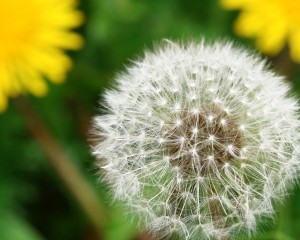
To listen to this reflection as a podcast, click here.
It’s Dandelion Explosion Season.
About the time that daily temperatures hover in the mid-70s, countless trillions of dandelions suddenly begin to bloom.
They thrive on all seven continents – even Antarctica. Historically, this member of the daisy family is prized as great medicine and great food.
It turns out that dandelions are storehouses of pharmacologically active compounds. For millennia they have been used in herbal remedies to treat infections, liver problems, kidney issues, and eczema. In Canada the dandelion root is a registered diuretic.
Furthermore, it’s not an exaggeration to say that this common herb is a super-food. Every part is edible.
The French, for instance, make a dynamite cream of dandelion soup. The leaves are prized as salad greens. They contain an abundance of vitamins A, C, and K, and are good sources of calcium, potassium, iron, and manganese.
Roasted dandelion roots can be turned into a caffeine-free coffee. The Brits have also transformed them into a soft drink. The yellow flower petals can be used to make dandelion wine. And since one of the medicinal uses of dandelions is to combat hangovers, this plant seems to solve the very crises it creates.
And let’s face it: Dandelions are beautiful. Even their name (from dent de lion, French for “lion’s tooth,” a description of their jagged green leaves) makes people smile.
So why do Americans think dandelions are from the Dark Side? Why does their presence in your next-door neighbor’s yard inspire such righteous indignation?
The answer is that we love our green lawns. And anything that seems to threaten our turf must be the enemy. But it’s a fight we can never win. In terms of biological survival, dandelions are dazzlingly successful.
Individual plants can live as long as 5-10 years. In other words, some of them might live longer on your property than you will.
What drives homeowners crazy is what we often see the morning after we finish mowing. How is it possible that dozens of white “pom-poms” are standing on 6-8 inch stalks as if we missed them altogether? In truth, you probably didn’t miss. But when the yellow petals go to seed, dandelion stalks can grow almost as fast as bamboo – quite literally while we are sleeping – so the tiny white parachutes have a better chance of being caught by the next breeze.
During America’s early years, when dandelions were cherished, it was said that those little white seeds were carried on the winds to the property of the one you love. If that’s so, then my yard this week is proof that I am more loved right now than I have ever imagined.
Dandelions are also living illustrations of the durability of great ideas and world-changing movements.
What’s the worst way to “destroy” a dandelion?
Just blow on that white cluster of seeds. In the moment, it feels like a major victory. You’ve reduced what was once a living, growing thing to a bare stalk.
But, of course, all you’ve managed to do is play right into the dandelion’s brilliant strategy of multiplication.
Something like that has happened again and again in spiritual history. From time to time, opponents have tried to blow away the followers of Jesus. Or eliminate people who stand up for virtue. Or silence new movements that aim to bring about greater justice. For that matter, Christians sometimes manage to blow things up all by themselves. They squabble with each other with such fierceness and foolishness that the church seems to be scattered to the four winds.
But all is not lost. Blowing on a dandelion seed-stalk is the best thing that could ever happen to it. All of a sudden there’s new growth in entirely new places.
It may seem that your own best hopes and expectations this spring have already been blown away by circumstances.
But don’t be surprised if God’s call on your life begins to bloom somewhere else.
Just as God always intended.
